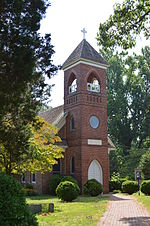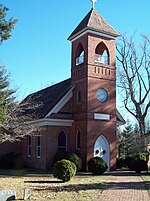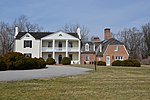Bellefields (Croom, Maryland)
1720 establishments in the Thirteen ColoniesBowie familyGeorgian architecture in MarylandHistoric American Buildings Survey in MarylandHouses completed in 1720 ... and 5 more
Houses in Prince George's County, MarylandHouses on the National Register of Historic Places in MarylandNational Register of Historic Places in Prince George's County, MarylandPrince George's County, Maryland Registered Historic Place stubsScottish-American culture in Maryland

Bellefields is a manor house located in Croom, Prince George's County, Maryland. It was constructed about 1720. It is a brick structure in Flemish bond with random glazed headers, and two stories over a high basement. The structure is rectangular, with gabled roof sections, paired interior end chimneys, a front center entrance, wide raised belt course above the first floor, flat arched openings, and flanking symmetrical single-story wings. It is in the Georgian style. It was the home of Patrick Sim, Scottish immigrant and of his son, Col. Joseph Sim, Maryland patriot.
Excerpt from the Wikipedia article Bellefields (Croom, Maryland) (License: CC BY-SA 3.0, Authors, Images).Bellefields (Croom, Maryland)
Duley Station Road,
Geographical coordinates (GPS) Address Nearby Places Show on map
Geographical coordinates (GPS)
| Latitude | Longitude |
|---|---|
| N 38.745833333333 ° | E -76.777222222222 ° |
Address
Duley Station Road 13204
20772
Maryland, United States
Open on Google Maps







